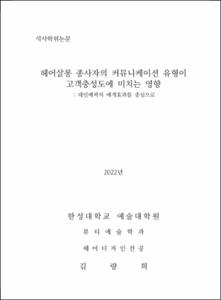헤어살롱 종사자의 커뮤니케이션 유형이 고객충성도에 미치는 영향
= The Effect of Communication Types of Hair Salon Workers on Customer Loyalty : Focusing on Mediation Effect of Interpersonal Attraction
- Type
- Thesis
- Alternative Title
- 대인매력의 매개효과를 중심으로
- Department
- 예술대학원 뷰티예술학과
- Issued Date
- 2022
- Publisher
- 한성대학교 예술대학원
- Keyword
- 커뮤니케이션 유형; 언어적 커뮤니케이션; 비언어적 커뮤니케이션; 대인매력; 고객충성도; 헤어살롱 종사자
- Files in This Item:
-
-
Download
 200000627413.pdf
기타 데이터 / 904.29 kB / Adobe PDF
200000627413.pdf
기타 데이터 / 904.29 kB / Adobe PDF
-
Items in Repository are protected by copyright, with all rights reserved, unless otherwise indicated.